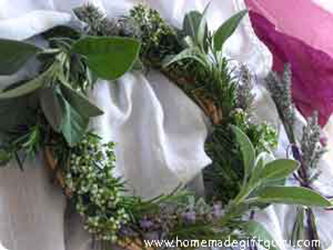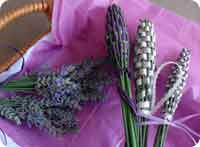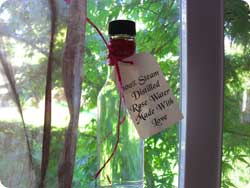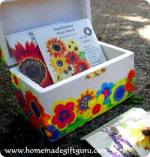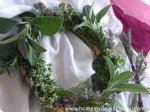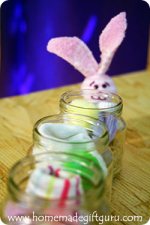Tasty Herbs and Edible Flower Guide
...because giving gifts from your garden is the BEST!
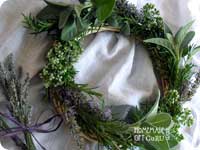
This herb and flower guide is designed to give you ideas for what to plant so that you can use your garden to the fullest, particularly when it comes to flower craft gifts and recipes using edible flowers and herbs.
Making gifts and arrangements from your own backyard is fun and fulfilling...
And just as cooking with food grown in your garden saves money, crafting with flowers and herbs from your own garden saves money too!
The following flower guide includes:
- A list of herbs and edible flowers for use in food recipes and flower craft arrangements...
- How to use edible flowers in food recipes... note the safety warning below about cooking with flowers!
- And also a bonus flower guide for dried arrangements, including a few of the best flowers for drying in bulk...
Herbs and Edible Flowers For Food and Crafts...
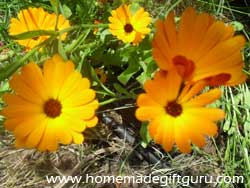
The following herbs and flowers are all edible. You can grow these herbs and edible flowers in your own backyard and use them in recipes, in herb bouquets and other flower crafts and floral arrangements...
Edible Herb and Flower Guide:
- Basil: Fresh basil (and dried) can be used in a variety of raw and cooked dishes. Basil can also be used in fresh flower bouquets (kept in a vase with water).
- Bay: Bay leaves actually grow bountifully on little bay trees. They can be cooked in beans, soups and many sauces (to be removed before eating). They also make fantastic additions to fresh and dried herb and flower crafts, bouquets and arrangements.
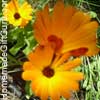
- Calendula: (Calendula oficinalis) The orange or yellow petals of the Calendula flower are great sprinkled on salads and other foods. Calendula is a peppery tasting flower that will turn an ordinary salad into a salad worthy of a special occasion such as a special Wedding or a Birthday party for example.
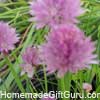
- Chives: The stems and flowers are edible. The flowers are especially wonderful when pulled apart and sprinkled on salads. The flowers can also be used in arrangements either fresh or dried.
- Dill "Dill Weed": Not only is dill an important herb used in pickling and many other recipes, it can be used as a cut flower filler.
- Fennel: Used as a filler in bouquets.
- Lavender: (L. angustifolia) This multi purpose herb/flower can be used fresh in bouquets. It can be dried for dried arrangements, sachets, sleep pillows, potpourri and other scented craft creations. It is edible and can be used sparingly in recipes. It can also be used to scent homemade soaps and in a variety of homemade bath and body recipes.
- Marjoram: Also known as wild oregano is a great choice for seasoning meats and sauces, as well as use in fresh and dried wreaths and other arrangements.
- Nasturtium: (Tropaeolum majus) This edible flower goes well in salads and some other recipes. The foliage lasts a long time in fresh flower arrangements but the flowers only last a couple days.
- Oregano: There are many types of oregano. Use them in cooking as well as fresh and dried wreaths and flower arrangements.
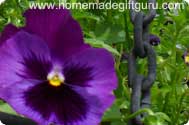
- Pansies: These popular cool weather flowers are actually edible. We put them in our cakes and pastries (especially purple pansies in lemon cake... see above for a pic) and on salads. Many colors of pansies such as yellows and blues make amazing pressed flowers for use in card making and other flower crafts.
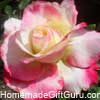
- Rose: Roses, rose buds and rose petals can be used in fresh flower arrangements, dried arrangements, potpourri and many homemade bath and body recipes. The petals of organically grown roses are edible and delicious. You'll find that many people use rose petals, rose oil and rose water (learn how to make your own rose water here) in a variety of food recipes, especially drinks such as lemonade and cocktails as well as desserts and icings.
- Rosemary: Rosemary is well used in a variety of dishes from sweet to savory. Rosemary is a beautiful addition to an herb wreath (it even flowers in the spring) and can be used in fresh flower arrangements (simply pull off the leaves below the water line) and dried arrangements as well. It is sometimes used in homemade bath and body recipes and certain potpourri
- Sage: Used in many savory dishes. Sage is also a wonderful addition to fresh flower bouquets, herb wreaths and some other dried arrangements. Sage flowers are also beautiful and edible.
- Thyme: Tasty in salads, poultry dishes and especially when making chicken stock. It also makes a great addition to an herb wreath and many other dried herb and/or flower arrangements. It gets little white flowers in June and July that look great in arrangements as well.
Other Popular Flowers That are Edible Include:
bachelor button, dandelion, hibiscus, lilac, bee balm, chamomile, daylily, hollyhock, marigold, squash blossom, borage, dianthus, impatiens, mint and violet.
Never eat a flower you are unsure of! More safety info and resources at the bottom of this page...
Safety Note When Crafting With Herbs and Flowers:
If you create an herb wreath, an herb bouquet or an herb arrangement, it is a good safety precaution to use only edible herbs and flowers (such as those above) since some plants and flowers are actually poisonous. People may decide to taste or eat the herbs and flowers or use them in cooking and an unknown variety of plant mixed in could be disastrous.
How to Use Edible Flowers in Food Recipes...
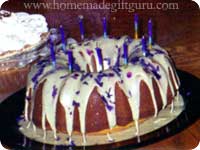
The edible herbs and flowers in the flower guide above can be used in gourmet food recipes such as salads, cooked dishes, drinks and cocktails, desserts, preserves as well as for garnishes.
They can also be used in flower craft arrangements such as fresh bouquets, herb wreaths, dried herb bouquets and crafts, body recipes or potpourris.
To use edible flowers in food recipes:
1. Pick Flowers:
Pick flowers in the morning after the dew dries but before it gets warm out.
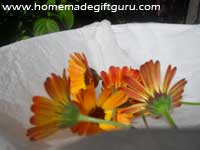
To keep the moisture level intact, put longer stemmed flowers such as Roses directly in a jar of water and layer short stemmed flowers such as Pansies or Calendula between damp paper towels (shown below).
2. Wash Flowers:
Use only organically grown pesticide-free flowers. Treat flowers delicately, check for insects and wash in cool water before using.
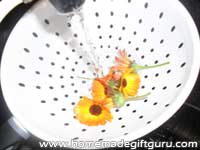
3. Prepare Flowers:
If using only the petals, remove them from the base now.
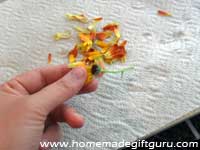 |
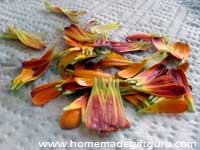 |
4. Store Flowers:
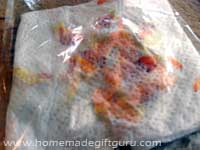
Use flower petals as soon as possible. If need be, you can store flower petals in between layers of damp paper towels and enclosed in plastic bags. Keep flowers cool preferably in the refrigerator. Most flower petals will last a day or so if stored properly.
Tips:
- Only use pesticide free and preservative free flowers in recipes.
- In most cases, you'll want to remove the pistils and stamens, using only the petals and sometimes the leaves.
- Some people are allergic to flowers due to pollen, these people should avoid eating flowers.
- Always taste flower petals before using them in recipes. This is because different colors, crops and varieties may have fairly different flavors that you will need to approve before using them in your dishes.
There are also many non-edible flowers that can be used in flower crafts... provided the project is not supposed to be edible in any way.
Dried Arrangements Flower Guide: Best Flowers For Drying
Here's a list of flowers that can be used to make up the bulk of such flower crafts as dried wreaths and other dried arrangements. Having these readily available will make your dried flower crafts cost less to make.
Note: This flower guide list is not edible, these are flowers great for drying in bulk.
- Baby's Breath (Gypsophila paniculata)
- Cockscomb (Celosia cristata)
- German Statice (Limonium tataricum)
- Globe Amaranth (Gomphrena spp)
- Larkspur (Consolida spp)
- Lavender (L. angustifolia)
- Love in a Mist (Nigella damascena)
- Pink Pokers (Limonium Suworowii)
- Statice (Limonium sinuatum)
- Strawflower (Helichrysum bracteatum)
- Victoria (Salvia farinacea)
We hope this flower guide gives you some great ideas for what to plant for flower craft gifts. There are surely many other plants and flowers you can plant as well.
In the Spring:
Be sure to fertilize your roses in the spring if you have some so you can gather a bounty of rose petals for homemade rose water this summer...
Also, trim the old dried flowers off your lavender plants as soon as you can for optimal lavender budding in the late Spring so you can make fragrant lavender bottles with lots of fresh blooms.
All Year Long:
You may also like this flower guide for dried pressed flowers!
Safety: According to the National Sustainable Agriculture Information Service post on the topic of Edible Flowers. Never eat azaleas, belladonna, calla lily, castor bean, crocus, daphne, foxglove, larkspur, lily-of-the-valley, nightshade, rhododendron or any flower or plant not known to be edible. Poison control can be reached at 1-800-222-1222 if anyone consumes a plant on this list of highly toxic plants or any plant not known to be edible and safe.
